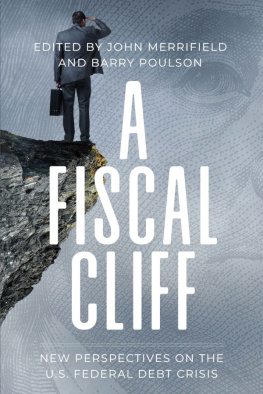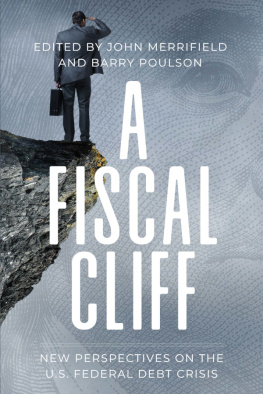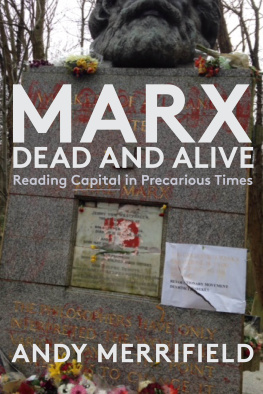John Merrifield - A Fiscal Cliff
Here you can read online John Merrifield - A Fiscal Cliff full text of the book (entire story) in english for free. Download pdf and epub, get meaning, cover and reviews about this ebook. year: 2020, publisher: Cato Institute, genre: Politics. Description of the work, (preface) as well as reviews are available. Best literature library LitArk.com created for fans of good reading and offers a wide selection of genres:
Romance novel
Science fiction
Adventure
Detective
Science
History
Home and family
Prose
Art
Politics
Computer
Non-fiction
Religion
Business
Children
Humor
Choose a favorite category and find really read worthwhile books. Enjoy immersion in the world of imagination, feel the emotions of the characters or learn something new for yourself, make an fascinating discovery.
- Book:A Fiscal Cliff
- Author:
- Publisher:Cato Institute
- Genre:
- Year:2020
- Rating:4 / 5
- Favourites:Add to favourites
- Your mark:
- 80
- 1
- 2
- 3
- 4
- 5
A Fiscal Cliff: summary, description and annotation
We offer to read an annotation, description, summary or preface (depends on what the author of the book "A Fiscal Cliff" wrote himself). If you haven't found the necessary information about the book — write in the comments, we will try to find it.
A Fiscal Cliff — read online for free the complete book (whole text) full work
Below is the text of the book, divided by pages. System saving the place of the last page read, allows you to conveniently read the book "A Fiscal Cliff" online for free, without having to search again every time where you left off. Put a bookmark, and you can go to the page where you finished reading at any time.
Font size:
Interval:
Bookmark:
FISCAL
CLIFF
AND BARRY POULSON
FISCAL
CLIFF

U.S. FEDERAL DEBT CRISIS

Copyright 2020 by the Cato Institute.
All rights reserved.
Print ISBN: 978-1-948647-87-8
eBook ISBN: 978-1-948647-89-2
Cover design: Jon Meyers
Library of Congress Cataloging-in-Publication Data
Merrifield, John, 1955 editor. | Poulson, Barry Warren, 1937- editor.
A fiscal cliff : new perspectives on the U.S. Federal debt crisis / John Merrifield and Barry Poulson, editors.
pages cm
Washington : Cato Institute, 2020.
Includes bibliographical references and index.
ISBN 9781948647878 (Paperback) | ISBN 9781948647892 (eBook)
1. Debts, Public--United States. 2. Public administration--United States. 3. Fiscal policy--United States.
HJ8101 .F47 2020
336.3/40973--dc23 2020024862
Printed in the United States of America.
CATO INSTITUTE
1000 Massachusetts Avenue NW
Washington, DC 20001
www.cato.org
The book is dedicated to the memory of Milton Friedman, who laid the foundations for rules-based fiscal and monetary policies.
D AVID W ALKER
B ARRY P OULSON
J OHN M ERRIFIELD
C HRIS E DWARDS
B ARRY P OULSON
CHAPTER FOUR
International Experience with Fiscal Rules
R YAN B OURNE
CHAPTER FIVE
The United States vs. Switzerland and Sweden: Three Approaches to Fiscal Restraint
R OMINA B OCCIA
CHAPTER SIX
Under Threat: Rules-Based Fiscal Policy and How to Preserve It
X AVIER D EBRUN AND L ARS J ONUNG
CHAPTER SEVEN
Rules for Sustainable Fiscal Policy: Three Perspectives
E D D OLAN
CHAPTER EIGHT
Effective Fiscal Rules Build on Consensus
K URT C OUCHMAN
CHAPTER NINE
Minutes from Midnight: Growing Pressure on the Treasury Market Could Lead to Default
B AKER S PRING
CHAPTER TEN
Fiscal Rules, Fiscal Policy, and Debt: A Dynamic Simulation Analysis
J OHN M ERRIFIELD AND B ARRY P OULSON
CHAPTER ELEVEN
Debt Reduction without Higher Taxes: Gradual Privatization of Federal Mineral Assets
N ICK L ORIS
CHAPTER TWELVE
Social Security and Medicare Spending Growth: Is It Just More Seniors or More Per Senior?
J OHN G AREN
CHAPTER THIRTEEN
Curb Rising Disaster and Emergency Spending
J USTIN B OGIE
CHAPTER FOURTEEN
Improving Transparency and Accountability in Federal Budgeting
R OMINA B OCCIA
CHAPTER FIFTEEN
Federal Budget Process Reform: Adding a Resource Constraint and Improving Cost Measurement
M ARVIN P HAUP
CHAPTER SIXTEEN
The Golden Rule of Public Finance and Prospects for Its Revival
R ICHARD M. S ALSMAN
CHAPTER SEVENTEEN
Administration vs. Politics in Theories of Democratic Budgeting
R ICHARD E. W AGNER
CHAPTER EIGHTEEN
Why Deficits?
D AVID J. H EBERT
CHAPTER NINETEEN
Fiscal Federalism and Dynamic Credence Capital in the United States
J OHN M ERRIFIELD AND B ARRY P OULSON
CHAPTER TWENTY
Controlling Government Spending: The Difficulty and the Hope
D WIGHT L EE
As the immediate former comptroller general of the United States and former head of the U.S. Government Accountability Office, I know a fair amount about the deteriorating financial condition of the U.S. government and its unsustainable fiscal outlook. I also have considerable experience in evaluating the financial condition and fiscal sustainability of various states and municipalities due to my experience as a managing director for PricewaterhouseCooperss Public Sector. More important, as a father and grandfather, I have a deep personal concern about the future impact of todays irresponsible fiscal actions and inactions on our children, grandchildren, and future generations of Americans.
The federal governments financial condition and fiscal outlook have deteriorated significantly since the end of fiscal year 2000. During this period, debt subject to the debt ceiling limit rose from about $5.7 trillion, or about 57 percent of gross domestic product (GDP), to more than $22 trillion, or about 110 percent of GDP in 2019. In addition, annual federal deficits are approaching $1 trillion and rising. They are also projected to further increase the debt-to-GDP ratio in the future, absent significant spending and revenue reforms.
The truth is that federal policymakers have lost control of the budget. Today only about 30 percent of the federal budget is controlled by Congress (discretionary spending), down from 97 percent in 1913 when the income tax and the Federal Reserve were established. In addition, the percentage of discretionary spending is set to decrease further due to rising costs associated with Social Security, Medicare, Medicaid, and other mandatory spending programs, along with interest on the federal debt. Shockingly, discretionary spending includes all the items that are expressly enumerated as a role for the federal government in the U.S. Constitution, including national defense and homeland security. And the fastest-growing expense today is interest on the federal debt, for which we get nothing.
Both political parties are to blame for this mess. Too many Republicans focus on cutting taxes today in an attempt to stimulate the economy without understanding the longer-range fiscal implications. Unfortunately, not all tax cuts stimulate the economy, and very few tax cuts pay for themselves. Too many Democrats want to increase the size and role of the federal government without paying for new programs and without understanding the implications on incentives to work, to marry, and to follow the legal immigration process.
Many current and historical fiscal controls have proved to be shortsighted and ineffective. For example, the debt ceiling limit has been totally ineffective in constraining debt burdens. Past attempts to control spending have not withstood the test of time. More fundamentally, Congress regularly fails to pass timely budgets and appropriations bills, resulting in periodic government shutdowns. During these shutdowns, members of Congress continue to get paid, and those civil servants who do not work during a shutdown still get paid retroactively when the shutdown is over. In addition, the current unitary federal budget approach has served to discourage legitimate and much-needed infrastructure projects that can benefit several generations.
While the federal government has its own major financial and fiscal challenges, many states and localities do too. Surprisingly, while all states but one have a balanced budget requirement, a number of states and localities have negative net positions, and many face large and growing structural deficits in the future due primarily to huge unfunded pension and retiree health care obligations. Municipalities can file for bankruptcy to restructure their finances, but state and federal governments cannot do so. And while the federal government has been able to handle much larger debt burdens at relatively low interest rates in recent years, it would be imprudent to think it can to do so in the future without a day of reckoning at some point. Such a day of reckoning would likely come suddenly and with devastating consequences both in the United States and around the world.
Font size:
Interval:
Bookmark:
Similar books «A Fiscal Cliff»
Look at similar books to A Fiscal Cliff. We have selected literature similar in name and meaning in the hope of providing readers with more options to find new, interesting, not yet read works.
Discussion, reviews of the book A Fiscal Cliff and just readers' own opinions. Leave your comments, write what you think about the work, its meaning or the main characters. Specify what exactly you liked and what you didn't like, and why you think so.













